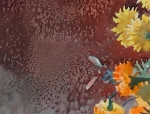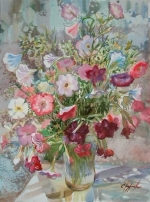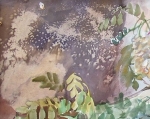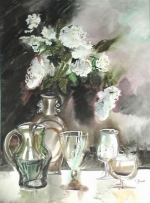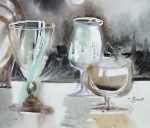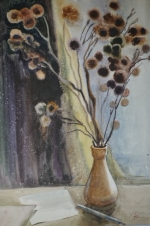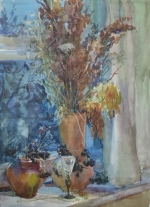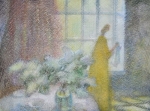The page is curated by - Aleh Kurashou;
Painting with watercolor as well as painting with oil, acrylic, tempera or any other paint is one of the components of easel painting. The technology of watercolor painting is extremely rich and diverse. Here we try to show some techniques basing on watercolors by Svetlana Kurashova.
|
Watercolor painting "using wet paper " (A La Prima) In this case artist uses wet paper to paint. The special (thick) paper is watered before painting and put horizontally (to save water as long as possible). Artist paints at wet surface. The painter must be maximally correct (it’s easy to get uncontrolled color drip or “dirt” – dark mixture of colors) and quick (the time when the paper is wet depends on the type of paper but it is limited anyway). |
|
Using wet paper at firs stage and finalizing the dried one Here the artist paints using wet paper, then waits until it dries and then refines the details. Such technique lets us combine soft “wet” background and hard accented details. |
|
Glazing – using many layers of watercolor. Using this technique an artist puts a few (2-3) transparent layers (glaze coats) of watercolor at dry sheet of paper. The picture gets a little bit “dry” if to compare with “wet” painting but it helps to get high level of details. It is called “glazing”. Glazing can be used at big areas of picture as well as at small ones. |
| Absence of white color (reservation, swerve, rounding) Everyone knows that there is no white paint in watercolor set. To make white spots artist uses paper whiteness. Artist must keep on thinking about the white places and lay on color not touching it, in other words – reserve place for white details. |
| Salt Coarse salt sifted on wet watercolor picture creates specific texture of color spots. |
|
Wash off Ready picture can be washed off with the help of running water. Some parts of picture are washed off hardly and the others remain unchanged. This method can spoil a picture or create a unique texture. |
|
Paraffin/wax Candle wax has a wonderful quality - water-repellency. It helps «protect« some parts of paper from watercolor. This method can be used at any stage of watercolor painting: at the start when the paper is clear as well as at the middle stage covering colored sports. Anyway the surface must be dry. |
|
Water spray Spraying water at wet watercolor surface creates points of light diffuseness. |
|
Back side of brush / palette knife When the picture is still wet some details can de scratched with back of brush or palette knife. |
|
Own style in watercolor The aim of every artist is to be recognized. Working hard the artist gets more experienced and discovers own art vision with own technology combination. In classical art it is a long way and demands good knowledge and practice. |
|
Mixed (combined) technique Some artists try to work beyond one technology. They start combine colors of various types and think out new ways of visualization. Such combination of various techniques is called “mixed or combined technique”. The beginners often call it “author’s technique” but mostly it is just an compilation of various techniques. |






